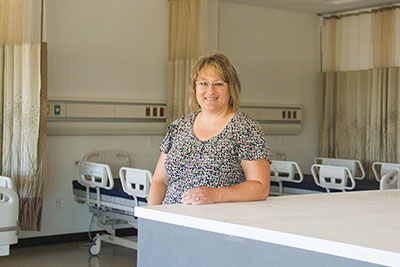Nursing: CWC flagship program front and center
January 1, 2013

The day has finally arrived. No longer will Central Wyoming College’s flagship program be hidden in a building down on the north 40 that was originally designed to teach vocational programs like auto and welding. Now the nursing program will be out front and center on the CWC campus in the new Health and Science Center.
“We’ve always been away and not really connected to the campus,” said Dean of Health and Science Kathy Wells. “That’s going to be a really exciting part of this building because we’re right in the heart of campus.”
The building, which is officially dedicated Sept. 20, makes it possible to expand the popular program though faculty must determine the best course to make that happen.
CWC promised voters in the 2010 bond campaign it would double admission into the program within three to five years once it had enough facilities and science labs to accommodate the students. Now, CWC must determine if there is sufficient faculty to teach science and other core courses required of nursing applicants.
“That piece needs to be in place so we can maintain the applicant pool in nursing,” said Health and Science Dean Kathy Wells.
While the Health and Science Center was under construction, Wells expanded the 2012 first-year nursing class by eight students “We did a test run last year and admitted 40 students to see if it was a better fit to manage more students per class or if we should look at admitting students twice a year,” she explained.
The faculty begins to weigh the pros and cons of admitting students in both the fall and spring semesters or have students complete the program in 18 months, speeding up the usual two-year completion time by offering courses year round without any time off.
Once all the options are investigated and students provide input, a plan will be implemented. Wells is most excited about having the entire health and science faculty together under one roof.
“Until this summer, we’ve been spread out in buildings throughout the campus,” she said. “It hasn’t been conducive for us to get to know each other well. The Health and Science Center will bring us together so we can work on some big picture projects.”
An immediate plan is to ensure courses are sequenced appropriately so students can complete their degrees in a timely fashion. Wells also oversees the operations at the CWC Jackson Center and wants to make certain the needs of students in Jackson are being met with the limited facilities there.
Wells is also looking to enhance programs within the Health and Science Division with capacity. The sciences “aren’t just here to support nursing,” she said. With greater visibility of the science programs and faculty, she believes many students will find their passion in research, pre-medicine, environmental science and more. She also expects students will be more involved assisting faculty in setting up labs, for example.
“The biggest impact comes in the sciences,” Wells said of the new facility. “There will be a better use of space.” For the first time, CWC’s Environment, Health and Safety program has dedicated lab space.
Other allied health programs are also getting more attention. The division is developing certificate and credential programs in medical assistant, pharmacy tech and health information technology.
The medical assistant program educates students to assist physicians in a clinical setting, such as taking vital signs of patients, sending orders to the lab and giving immunizations. The semester-length course prepares students for certification that includes an “intensive externship.” In addition to completing the formal education component, students work in a clinical setting. The new facility has a lab for the students to practice their new-found skills that mimic the office environment.
Wells is also “really, really excited” about the development of a pharmacy technician program. The state has been considering a formal education requirement for assistants who now mostly receive on-the-job training in the pharmacy. “We would absolutely bring that program on board,” she said. “If this does become a requirement, the state will need several more programs.”
The college has been advertising for a faculty member for Health Information Technology (HIT), a program using a global umbrella term for two skills track – one for the user and the other on the support side.
Part of the program development is revamping and restructuring courses in medical transcription, medical coding and billing. “We are looking to change the program requirements to update it and to meet the current needs of employers,” Wells said, explaining she will recruit potential employers for an active advisory committee.
In the past, most of those courses had been offered online, which Wells will continue though she will offer face-to-face instruction depending on the demand of students.
There is now a federal requirement of maintaining electronic medical records that creates the need to focus on an IT perspective within health care, she said. Courses in programming and security will be developed while continuing to provide the knowledge of health care and managing patient privacy.
The curriculum has already been approved for a Certified Nursing Assistant II and medications assistant. Wells is also investigating a program. In the future, she will also consider the development of a program in medical laboratory technology.
CWC’s Health Care Solutions grant staff will also be located in the Health and Sciences Center. The grant offers financial and other support to students seeking careers in health care. The director and case managers will have a closer connection to the students being served as they will be taking classes in the same building.